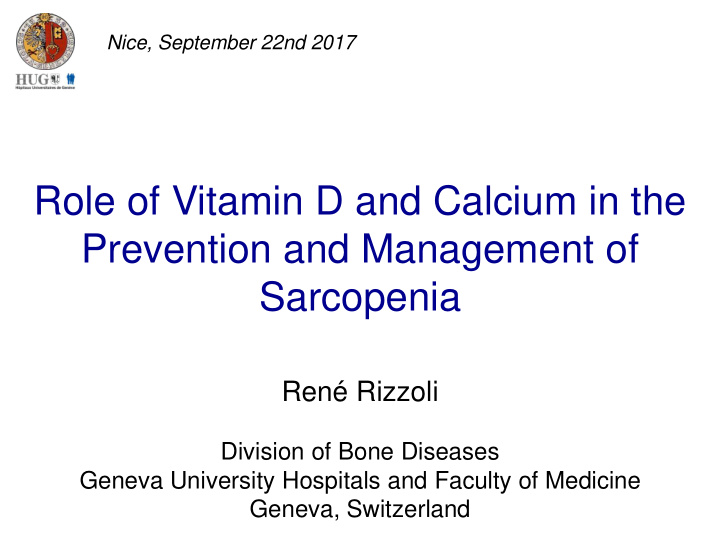



Nice, September 22nd 2017 Role of Vitamin D and Calcium in the Prevention and Management of Sarcopenia René Rizzoli Division of Bone Diseases Geneva University Hospitals and Faculty of Medicine Geneva, Switzerland
Disclosure Speaker Bureau or Member of Scientific Advisory Boards for Amgen, Danone, Labatec, Nestlé, ObsEva, Radius Health
Pathogenesis of Osteoporotic Fracture Falls Osteoporosis Sway Walking Muscle Strength Neuro-muscular Impairment Mechanical Overload Mechanical Incompetence Fracture Calcium? Fracture Repair Vitamin D ? Rehabilitation -> To Restore Independence -> To Reduce Disabilities Prevention Subsequent Fracture
Sarcopenia and Calcium Intakes (Cross-sectional Studies) Author Sample Size Mean Age/ Outcome Results (% Women) Calcium Intake 1’339 Seo et al. 70.1 Muscle Mass Prevalence (tertiles): 2013 (53) 3rd Tertile Sarcopenia 6.3, 4.3, 2.7 % ≥444 mg/d (KNHANES IV) (DXA) OR: 0.259 Waters et al. 315 76.5 Performance OR (lowest quartile: 2014 (62) 769 vs 909 (Gait speed, 2.18 (NS) (New Mexico mg/d in M m/s) Lower Calcium in M Aging M: 0.8; W: 0.7 Process) 1’433 Oh et al. 68.6 Sarcopenia Difference in Men , 2015 (64) 69 vs 77 (DXA, not in Women KNHANES %DRI Muscaritoli) Ter Borg et al. 227 74.0 Sarcopenia No difference in 2016 (52) 869 mg/d (Cruz-Jentoft) calcium intake Verlaan et al. 132 71.0 Sarcopenia No difference in 2017 (59) 830 mg/d (Cruz-Jentoft) calcium intake (Case-Control)
Institute of Medicine 2010
Dose-response for 25(OH)D and function NHANES III: n = 4100 community – dwelling older individuals age 60+ Repeated sit-to-stand 8-Foot walk 4.5 16 Sec Sec 15 4 14 3.5 0 20 40 60 80 100 120 140 160 180 200 220 240 0 20 40 60 80 100 120 140 160 180 200 220 240 25-OHD nmol/l 25-OHD nmol/l Effect was similar between more or less active individuals, men or women, calcium intake Bischoff-Ferrari HA, Dawson-Hughes B et al. Am J Clin Nutr. 2004;80:752 – 758.
Beaudard et al JCEM 2014
Balance TUG No Effect on Gait Speed Muir et al JAGS 2011
Meta-analyses on Vitamin D and Fall Prevention 26 RCT/ 12 Meta-analyses = 2.1 26 RCT,n= 45’782 Harvey, Biver et al 2016
Vitamin D and Exercise in Fall Prevention Among Older Women No Exercise ± VitD Baseline 25OHD 27 ng/ml (67.5 nmol/l) With Exercise ± VitD 800I U/d Uusi-Rasi et al JAMA Int Med 2015
Severe Vitamin D Deficiency in Hip Fracture Patients % Severe 25(OH)D deficiency: 80 70 25(OH)D < 30 nmol/l 60 50 40 home 30 20 assisted living 10 0 nursing home % with severe deficiency % supplemented (n = 222) Bischoff-Ferrari et al Bone 2007
Baseline 25OH D 32 nmol/l Extended Physiotherapy -> Reduction Falls, but not Hospital Readmission Vitamin D 2’000 IU/d -> Reduction Hospital Readmission, but not Falls Bischoff-Ferrari et al. Arch Intern Med 2010
Relative Risk of Falling with Vitamin D Supplementation Bischoff-Ferrari BMJ 2011
High- Dose Vitamin D (500’000 IU) and Falls and Fractures in Older Women Falls Fractures Cumulative Incidence of fractures % 20 100 Cumulative incidence of falls % Vitamin D Vitamin D Placebo Placebo 15 75 10 50 HR 1.16 HR 1.26 (CI 1.05-1.28) (CI 0.99-1.59) 5 25 P =0.06 P = 0.003 0 0 1 2 3 4 5 0 1 2 3 4 5 0 Time (Years) Time (Years) Sanders et al., JAMA 2010;303:1815-1822
78 Yrs (>70), 58% with 25OHD < 20 ng/ml (50 nmol/l), 12 Mo Monthly: 24’000 IU VitD3 vs 60’000 IU VitD3 vs 24’000 IU VitD3 & 300 µg Calcifediol Bischoff-Ferrari et al JAMA Int Med 2016
12 Months 75-100 nmol/l Baseline 25OHD: 38 nmol/l Smith et al J Ster Bioch Mol Biol 2017
Vitamin D and Sarcopenia • Summary – Vitamin D Supplementation Seems to Reduce Fall Risk – Particularly in Vitamin D-insufficient Subjects – Dose (800- 1’000 IU/ day) and Continuous Administration are Likely Important Factors • Conclusion – Vitamin D Repletion is Efficacious and Safe, and should be Included in Strategies Aimed at Preventing Sarcopenia
May be for Falls, Upper Intake of Vitamin Should be Revisited Institute of Medicine 2010
Recommend
More recommend